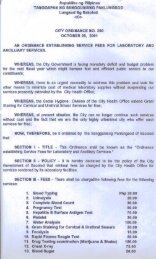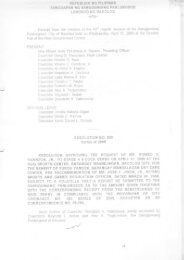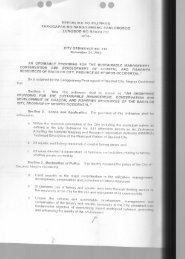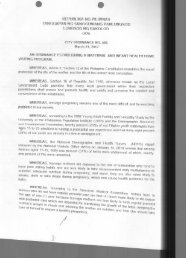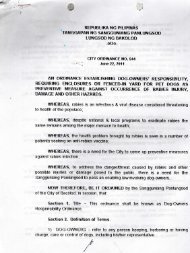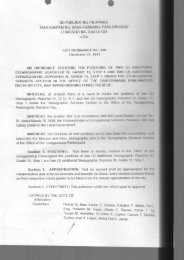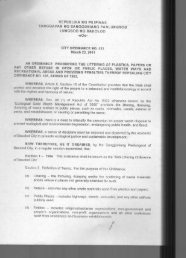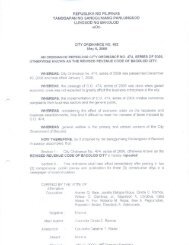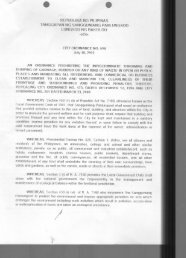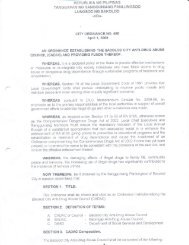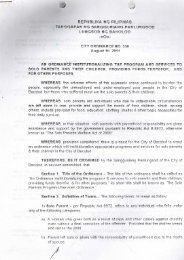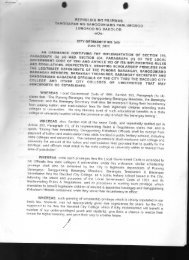City Ordinance No. 570 - Bacolod City
City Ordinance No. 570 - Bacolod City
City Ordinance No. 570 - Bacolod City
Create successful ePaper yourself
Turn your PDF publications into a flip-book with our unique Google optimized e-Paper software.
CHy <strong>Ordinance</strong> <strong>No</strong>. <strong>570</strong><br />
December 1, 2011<br />
Page 7<br />
7. 2. Re-use. Reuse is not only finding another use for a product but, more<br />
importantly, reusing product over and over again for a given function as intended.<br />
7. 3. Recycling. Recycling is collecting waste and processing it into something new.<br />
Many items in the hospital can be recycled, items such as organics, plastic, paper,<br />
glass and metal can be recycled easily.<br />
7. 4. Segregation of Waste. Segregation, is an important step to waste<br />
management.<br />
7, 5. Composting. Composting is another important strategy to minimize waste such<br />
as food discards, kitchen waste, cardboard, and yard waste.<br />
CHAPTER II<br />
Waste Handling, Collection,<br />
Storage, And Transport<br />
SECTION 8. Waste Segregation Color Coding Scheme. Hazardous waste<br />
should be placed in clearly marked containers that are appropriately labeled for the type<br />
and weight of the waste. Except for sharps and fluids, hazardous wastes are generally put<br />
in plastic bags, plastic lined cardboard boxes, or leaked proofed containers that meet<br />
specific performance standards.<br />
The following color scheme shall be strictly observed:<br />
Black - For <strong>No</strong>n-infectious dry waste<br />
Green - <strong>No</strong>n-infectious wet waste (kitchen, dietary etc.)<br />
Yellow - Infectious and Pathological Waste<br />
Yellow with Black Band - Chemical Waste including those with heavy metals<br />
Orange - Radioactive wastes<br />
Red - Sharps and pressurized containers<br />
SECTION 9. Other Medical and Toxic Waste Segregation Practices. Apart from<br />
the color-coding system for medical and toxic wastes, the following practice should:<br />
9.1. Residuals of the general health care waste should join the stream of<br />
domestic refuse or municipal solid waste for proper waste management.<br />
9.2. Sharps should all be collected together, regardless of whether or not they<br />
are contaminated. Containers should be puncture proof (usually made of<br />
metal or high-density plastic) and fitted with covers. It should be rigid and<br />
impermeable to contain not only the sharps but also any residual liquids<br />
from syringes. To discourage abuse, containers should be tamper proof



